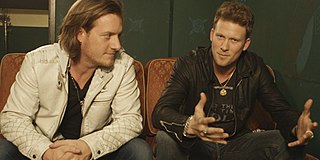
At the start of 1958, Billboard magazine published two charts specifically covering the top-performing country music songs in the United States. The C&W Best Sellers in Stores chart ranked records based on their "current national selling importance at the retail level", based on a survey of record retailers "with a high volume of sales in country and western records". [1] The Most Played C&W by Jockeys chart ranked songs based on the "number of plays on disk jockey radio shows" according to a weekly survey of "top disk jockey shows in all key markets". [1] With effect from the October 20 issue of Billboard the magazine discontinued both charts and combined sales and airplay into one chart called Hot C&W Sides, which has been published continuously since that date, currently under the title Hot Country Songs. In 1990 it changed to being based solely on airplay from country music radio stations, before reverting to a combined sales and airplay chart in 2012 but utilizing airplay data from stations of all formats as well as digital sales and streaming. [2]
Contents
The number one song on the Best Sellers chart in the first issue of 1958 was "Great Balls of Fire" by Jerry Lee Lewis, and the song at the top of the Jockeys chart was "The Story of My Life" by Marty Robbins; both songs replaced "My Special Angel" by Bobby Helms, which had topped both charts the week before. [1] Eight different singles topped the Best Sellers chart, including two each by Johnny Cash, Don Gibson and the Everly Brothers. The longest unbroken run in the top spot was eight weeks, achieved by both of Cash's chart-toppers, "Ballad of a Teenage Queen" / "Big River" and "Guess Things Happen That Way" / "Come In, Stranger"; in each case the B-side of the single was listed jointly at number one for some or all of its time in the top spot under the methodology in use at the time. The sixteen weeks which Cash spent at number one was the most for any act. Gibson's "Oh Lonesome Me" also spent eight weeks at number one, but in two separate runs. The song gave Gibson his first number-one country song and he would go on to achieve his second later in the year with "Blue Blue Day". He remained popular in the 1960s, but did not return to the top of the country singles chart until 1972. [3] [4]
Three singles which topped the Best Sellers chart did not reach number one on the Jockeys chart: "Great Balls of Fire" by Lewis, "Blue Blue Day" by Gibson, and "Bird Dog" / "Devoted to You" by the Everly Brothers. "Alone With You" by Faron Young had the longest unbroken run of the year on the airplay-based listing, spending 13 weeks in the top spot. Despite its popularity on the radio, the song was one of two Jockeys chart-toppers never to top the Best Sellers chart, the other being "Just Married" by Marty Robbins. The separate sales and airplay charts were published for the final time in the issue of Billboard dated October 13. The final Best Sellers number one was "Bird Dog" / "Devoted to You" and the last Jockeys chart-topper was "Alone With You". The following week the magazine launched the combined Hot C&W Sides chart, based on playlists submitted by country music radio stations and sales reports submitted by stores. [5] [6] The first number one on the new chart was "City Lights" by Ray Price, which in the previous issue had been at number 2 on the Best Sellers chart and number 4 on the Jockeys chart. [7] Price's song would remain at number one for the remainder of 1958.





